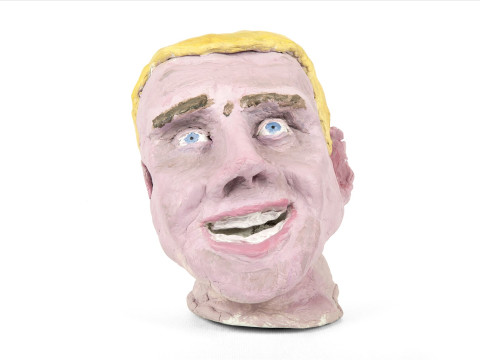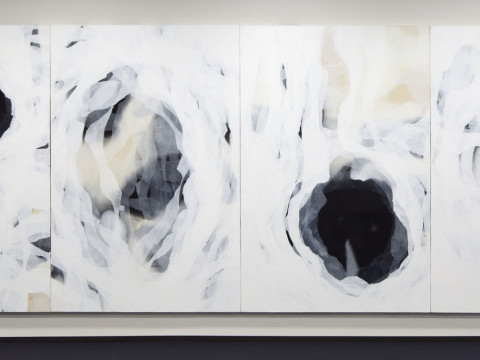
Tony Cragg: "sculpture is a vital sign"
By Alice Primrose
Published on 4 March 2017
How do you make work indoors that's destined for a life outdoors? With the opening of his exhibition at Yorkshire Sculpture Park, the artist discusses the realities of making art surrounded by rats, sunshine and Henry Moore.
“We’re getting rats in the place Cragg – tidy up!” It was this reprimand about the state of Tony Cragg's studio at the Royal College of Art – from the tutor and sculptor Bernard Meadows – that sparked the artist’s interest in stacking materials in towers. A speedy tactic to clear the floor and stay out of trouble soon became a career-long fixation with piling upwards.
Forty years later, these stacks can be seen dotted throughout Yorkshire Sculpture Park, where his solo exhibition has just opened – as well as in collections across the world, from MoMA in New York, to the Guggenheim in Venice and Tate Modern in the artist's home country. In the new show, 14 of his works stand proud in the undulating Yorkshire landscape, while the park’s galleries display scores more sculptures, paintings and prints. It's clear there has been an evolution in the artist's stacking: from earlier works such as Minster – several piles of “abandoned pieces of scrap metal” – to gleaming forms from the last decade, which Cragg more elegantly describes as “stacked horizontal ellipses”. Cragg conceives of the show as “a survey of where the practice is at this particular moment”, though it’s an idea that has been quietly brewing for years. As we meander around the artist’s sculptures, he remembers discussions with the park’s founder over two decades ago, but adds, waving his hand over the lush green vista, “there’s no way I could have done all this then”.

Minster, 1990

Mean Average, 2013

Points of View, 2013
Wandering around the park, it’s difficult to separate Cragg’s forms from their new setting: they look as though they belong in the landscape, as though they originated from the earth. The sculptures ebb and flow ambiguously between biological, anatomical and geological. For decades, the artist’s practice has probed at the peculiarities of what is perceived to be man-made and natural: why is a bird’s nest always considered to be natural, whereas a house usually is not? In this sense, his sculptures are in the perfect setting. Yorkshire Sculpture Park sits on the centuries-old Bretton Estate – a seemingly natural landscape very deliberately crafted in the 18th century to optimise the lavish parties, mock naval battles, yachting afternoons and firework displays put on by its aristocratic residents. As Cragg points out, “it’s actually a very clear, man-made, formal construction that we’re working within.”
Every ripple of sculpture glows in the sunshine on the day we visit – but this glorious weather is “not at all how I like them to be seen”, the artist says, enviously recalling a Henry Moore catalogue full of sculptures shot at dawn amid silvery mist. Despite Cragg himself being one of the most renowned British sculptors of his generation, the legacy of Henry Moore casts a long shadow over his conversations. For years, he avoided bronze sculpture (hence the scrap metal) – "what can you even do with that after Henry Moore?" – but as the show at YSP demonstrates, he has embraced the medium in the last two decades.

Caught Dreaming, 2006

Caldera, 2008

Tommy, 2013
Though very much thought of as a British sculptor, Cragg and his oeuvre have travelled to Yorkshire from his hillside studio in Wuppertal, a city east of Düsseldorf in Germany (and the setting of Wim Wenders’ film Pina). His practice has been based there since the 1970s, and he describes the setup as a large complex of various rooms and workshops – including a “private domain," just to "sit in, draw in, and model”. In the workshops he works closely with a team of artisans – in contrast, he says, to his contemporaries in the 1980s who sat at their desks amid a stack of drawings and proclaimed “let them be made”. Cragg needs to “know and experience the process,” he explains. “I need to see the change in form, the stages, the emotional effect of those changes… I don’t plan the thing. The thing is to make it in the studio, and it depends how I feel as to how the work feels”.

The workshops are specialised to grapple with almost any material, from polystyrene to plywood or stainless steel, but bronze designs have to be prized out of the artist's hand to be cast at foundries elsewhere. It is another reason why Cragg has been reluctant to use the material in his work: relinquishing control to forces outside of his own studio felt just as uncomfortable as that lingering shadow cast by the sculptor's predecessor. Two foundries refused to make a bronze version of Group, a plywood sculpture indoors that looks like the view through a biologist’s microscope, he says, “which is always a good sign that no one else is doing it”. But as Cragg acknowledges, “if you want to make work to stand outside in all weathers, there are only so many materials you can choose from”.
The appeal of making work that can stand outdoors lies in the space. “You’re not confined by architecture, whether that’s weight-wise or height-wise. The confinements drop away. Suddenly the sculptures are very small, because the trees are bigger and the fields are bigger and the clouds are bigger”. At YSP, this idea has been explicitly explored with two incarnations of the same sculpture: one inside, the other outside, separated by a glass wall. Inside, blocking one of the corridors, Runner’s zigzag wooden form seems to have been squashed from above so as not to touch the ceiling. Outside, its bronze counterpart of the same name is let loose in the open air, as though magic beans were planted in the ground not long ago.

Runner, 2015

Runner, 2013
And yet, most of the time, Cragg isn’t preoccupied with where his sculptures will eventually be seen. “When I’m in the studio, I don’t want to think about how the works will fare once they leave. I have themes and motifs and interests that I want to follow, and I don’t want to be conditioned by – or know about – anybody else’s problems”. Nonetheless, as his sculptures get taller and heavier, they are by necessity destined for a life outdoors. Even in Cragg’s studio, the ceilings are seven metres tall, but some works can’t be fully assembled until they’re in open air.
Cragg, of course, is no stranger to that challenge. He has founded his own sculpture park – Skulpturenpark Waldfrieden – near his studio in Germany, where the landscape is populated with his own creations alongside works by Richard Deacon, Thomas Schütte and even Henry Moore. Much like his Wuppertal park and studio, the show at YSP is an adventure through the persistent thrills of making – often, still, of making upwards – and of affirming your own continuing presence. “We’re all fighting for our existence in a material environment; the force of gravity would like to pull us underground. There’s lots of dynamic energy involved in keeping a form upright. Making a sculpture for me is about making a vital sign.”
Tony Cragg: A Rare Category of Objects, Yorkshire Sculpture Park, until 3 September 2017.
Related articles

Jock McFadyen RA: postcards from a post-apocalyptic future
28 February 2022

Video: Annette Fernando at the Summer Exhibition 2021
3 December 2021

Light Lines Tour with Hélène Binet
23 November 2021


